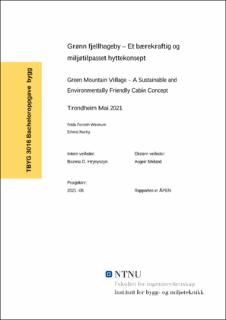| dc.contributor.advisor | Hrynyszyn, Bozena Dorota | |
| dc.contributor.advisor | Meland, Asgeir | |
| dc.contributor.author | Norby, Erlend | |
| dc.contributor.author | Westrum, Frida Forseth | |
| dc.date.accessioned | 2021-09-20T16:33:22Z | |
| dc.date.available | 2021-09-20T16:33:22Z | |
| dc.date.issued | 2021 | |
| dc.identifier | no.ntnu:inspera:81154281:81155142 | |
| dc.identifier.uri | https://hdl.handle.net/11250/2779549 | |
| dc.description.abstract | Denne bacheloroppgaven er utarbeidet på vegne av oppdragsgiver, Nasjonalparken Næringshage AS. Oppgaven er en utvikling av et bærekraftig og miljøtilpasset hyttekonsept med relativt frie tøyler på prosjektering. Hytteområdet ligger i Oppdal kommune i tilknytning til Rønningslia gård. Gården driver blant annet med eggproduksjon og utsalg av råvarer, og vil være nyttig for konseptet.
Fremtidens hyttetrend utvikler seg mot å bygge stort og ta opp arealer. Det er mye snakk om bærekraft i dagens samfunn, men det er ikke bærekraftig å fortsette en slik trend. Prosjektet skal derfor som et ønske fra Nasjonalparken Næringshage, sikte seg inn mot en bærekraftig tilnærming til hytteutbygging. Oppgaven vil ta for seg en prosjektert hytte, i tillegg til å se på hyttefeltes helhet. Det vil legges stor vekt på arealeffektivitet og minimale terrenginngrep for å gjøre hyttekonseptet bærekraftig. Landskapet skal betraktes som hovedfundamentet i prosjektet, hvor variasjonene og innholdet i terrenget legger føringer for hvordan prosjektet skal utvikles, både med tanke på planarbeid og bygningskonstruksjon.
Store deler av energiforbruket til hytter er knyttet til oppvarming. Gjennom oppgaven har det derfor blitt vurdert ulike materialer, konstruksjonsprinsipper og tekniske installasjoner opp mot hverandre for å bidra til at hytta blir mer energieffektiv når den er i bruk. Det har også blitt vurdert ulike energikilder som kan bidra til oppvarming og drift av hyttene, hvor da solceller på taket til hønsehuset og overskuddsvarme fra hønsegården kan bli benyttet.
Resultatet ble utforming av en hytte med bruksareal på 49,2 kvm. En arealeffektiv hytte med frittliggende bod og uteområde. Det er blitt lagt fram et forslag på én planløsning, med muligheter for å utvikle flere. Halve hytteområdet er tiltenkt bebyggelse, og resterende vil være bevart landskap som brukes til rekreasjon. Hyttene har åpen fundamentering på stålpæler, veggen er bygd opp med todelt bindingsverk, og taket er et saltak med isolerte takflater og luftet tekning. Det er benyttet treverk både i konstruksjonen og på overflater, da dette er et kortreist og fornybart material | |
| dc.description.abstract | This bachelor thesis is conducted on behalf of Nasjonalparken Næringshage AS. The thesis explores a sustainable, environmental-friendly way of building mountain cabins, with relatively few restrictions regarding planning and design. Oppdal municipality is the home of the cabin field, and the property is part of Rønningslia farm. Amongst other things, the farm is producing eggs and other commodities, which will be useful for the thesis’ concept.
The cabin trends of the future tend to shift towards building big and henceforth claim large areas of land. This is not a trend that fits well with one the central points of the public discourse of our time, sustainability. The thesis will therefore have a sustainable approach, as desired by the client. In the project, one cabin will be projected as an example, while the cabin field will be viewed as one unit. To make the concept sustainable, areal efficient cabins, with diminutive intervention to the surrounding terrain will be laid weight on. The landscape will serve as the main foundation of the project, and its natural variations will guide how the project evolves, regarding both planning and building.
Heating of the cabins is cause to a significant part of their energy consumption. The thesis therefore compares different materials, principles of construction and technical installations in the projected cabin to make sure the cabins will be as energy efficient as possible when they are ready for use. Different sources of energy are also considered for heating of the numerous cabins in the field. An example being solar cells on the roof of the chicken coop, which then leads to eventual excess heat from the coop being used in the cabins.
The result is a cabin with a net internal area of 49,2 square meters. An area-efficient cabin with a detached shed and outdoor area. A proposal for a floor plan has been made, with the possibility to create more. Half of the area for the cabin field is intended for buildings, while the other half is dedicated for recreational purposes. The cabins have an open foundation on steel poles, and the walls are constructed as double-stud walls. It has a gable roof with separate wind barrier and an underlayer roof. The materials in the construction and on the surfaces are mainly woodwork, as it is both produced nearby and a renewable material.
| |
| dc.language | nob | |
| dc.publisher | NTNU | |
| dc.title | Grønn fjellhageby – Et bærekraftig og miljøtilpasset hyttekonsept | |
| dc.type | Bachelor thesis | |
